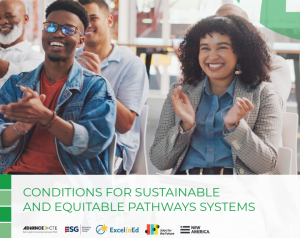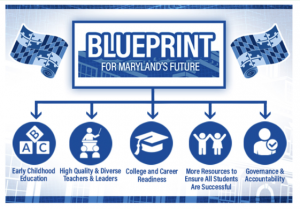Launch, through the expertise of the five national partners, has supported 15 cross-sector teams from 14 states since 2022 to identify and advance policies and strategies in education and workforce systems that promote economic mobility for all learners. Launch also aims to create greater scale and sustainability in states’ college and career pathways systems.

College and career pathways policies affect multiple systems, including K–12 and postsecondary education and the public workforce system, as well as both state and local agencies and institutions. As such, these policies must take a systemic and cohesive approach; build on best practices in the field; and where possible, be informed by data. Below are three examples of how states from the Launch initiative are using policy to build college and career pathways for scale and sustainability.
Maryland
The Blueprint for Maryland’s Future was developed from recommendations made by the Commission on Innovation and Excellence in Education, which met from 2017 to 2019. Enacted into law in 2021, the Blueprint aims to provide equitable access to high-quality education to all Maryland learners, enhance learner outcomes, and strengthen the state’s workforce. In 2023, the Maryland State Department of Education and each of the state’s 24 local education agencies developed Blueprint Implementation Plans to chart a path toward meeting the goals articulated in the Blueprint’s five pillars, including those in Pillar Three: College Career.
The Blueprint’s College and Career Readiness pillar establishes a clear, statewide vision for college and career readiness. It promotes rigorous standards to ensure that learners are prepared for success after high school and calls for the expansion of dual enrollment, college and career pathways, and opportunities to earn industry-recognized credentials. For example, the Blueprint has set goals for expanding Career Technical Education (CTE) and ambitious targets for learner participation programs leading to an industry-recognized occupational credential, notably that 45% of public high school learners will graduate having completed the high school level of a Registered Apprenticeship or another industry-recognized credential.
Colorado

Specifically, the task force found opportunities for greater policy coherence, including the need for the state’s current accountability system to fully measure how schools and districts prepare their learners for postsecondary education and the workforce. The 1241 Task Force work culminated in a November 2024 report detailing the recommended improvements to the way Postsecondary & Workforce Readiness opportunities are measured, recognized, rewarded, and incentivized within the accountability frameworks.
Illinois

Critically, the PWR Act aims to require and support coordinated efforts among school districts, postsecondary education institutions, employers, and other public and private organizations to implement four aligned strategies to address key barriers to the successful transition of Illinois high school learners into college and careers.
One key strategy was the development of a Postsecondary and Career Expectations (PaCE) framework. To further institutionalize a key aspect of this law and build more policy cohesion, in 2022, the state adopted a new policy requiring that school districts establish career pathway endorsement programs and adopt either the model Illinois PaCE Framework or a customized version during the coming years. Various agencies in the state have collaborated to develop joint implementation tools to both support and learn from local implementation efforts.
Dive into additional state examples and the conditions that enable accessible and sustainable high-quality pathways systems at scale across the five levers of policy, funding, partnerships, data, and equity in the first publication from the Launch initiative Conditions For Sustainable and Equitable Pathways Systems.



